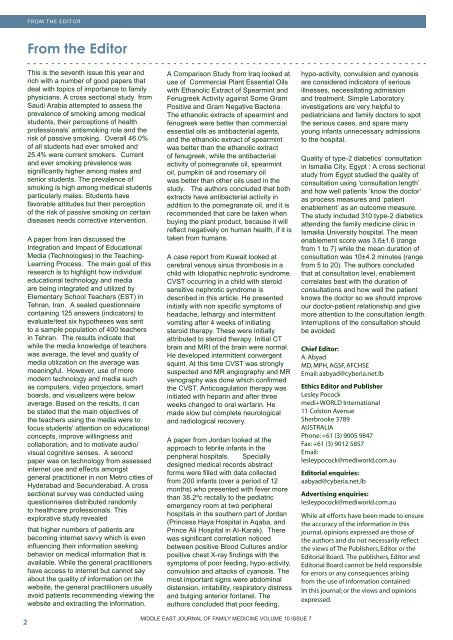full pdf of issue - Middle East Journal of Family Medicine
full pdf of issue - Middle East Journal of Family Medicine
full pdf of issue - Middle East Journal of Family Medicine
- No tags were found...
Create successful ePaper yourself
Turn your PDF publications into a flip-book with our unique Google optimized e-Paper software.
FROM THE EDITORFrom the EditorThis is the seventh <strong>issue</strong> this year andrich with a number <strong>of</strong> good papers thatdeal with topics <strong>of</strong> importance to familyphysicians. A cross sectional study fromSaudi Arabia attempted to assess theprevalence <strong>of</strong> smoking among medicalstudents, their perceptions <strong>of</strong> healthpr<strong>of</strong>essionals’ antismoking role and therisk <strong>of</strong> passive smoking. Overall 46.0%<strong>of</strong> all students had ever smoked and25.4% were current smokers. Currentand ever smoking prevalence wassignificantly higher among males andsenior students. The prevalence <strong>of</strong>smoking is high among medical studentsparticularly males. Students havefavorable attitudes but their perception<strong>of</strong> the risk <strong>of</strong> passive smoking on certaindiseases needs corrective intervention.A paper from Iran discussed theIntegration and Impact <strong>of</strong> EducationalMedia (Technologies) in the Teaching-Learning Process. The main goal <strong>of</strong> thisresearch is to highlight how individualeducational technology and mediaare being integrated and utilized byElementary School Teachers (EST) inTehran, Iran. A sealed questionnairecontaining 125 answers (indicators) toevaluate/test six hypotheses was sentto a sample population <strong>of</strong> 400 teachersin Tehran. The results indicate thatwhile the media knowledge <strong>of</strong> teacherswas average, the level and quality <strong>of</strong>media utilization on the average wasmeaningful. However, use <strong>of</strong> moremodern technology and media suchas computers, video projectors, smartboards, and visualizers were belowaverage. Based on the results, it canbe stated that the main objectives <strong>of</strong>the teachers using the media were t<strong>of</strong>ocus students’ attention on educationalconcepts, improve willingness andcollaboration, and to motivate audio/visual cognitive senses. A secondpaper was on technology from assessedinternet use and effects amongstgeneral practitioner in non Metro cities <strong>of</strong>Hyderabad and Secunderabad. A crosssectional survey was conducted usingquestionnaires distributed randomlyto healthcare pr<strong>of</strong>essionals. Thisexplorative study revealedthat higher numbers <strong>of</strong> patients arebecoming internet savvy which is eveninfluencing their information seekingbehavior on medical information that isavailable. While the general practitionershave access to internet but cannot sayabout the quality <strong>of</strong> information on thewebsite, the general practitioners usuallyavoid patients recommending viewing thewebsite and extracting the information.A Comparison Study from Iraq looked atuse <strong>of</strong> Commercial Plant Essential Oilswith Ethanolic Extract <strong>of</strong> Spearmint andFenugreek Activity against Some GramPositive and Gram Negative Bacteria.The ethanolic extracts <strong>of</strong> spearmint andfenugreek were better than commercialessential oils as antibacterial agents,and the ethanolic extract <strong>of</strong> spearmintwas better than the ethanolic extract<strong>of</strong> fenugreek, while the antibacterialactivity <strong>of</strong> pomegranate oil, spearmintoil, pumpkin oil and rosemary oilwas better than other oils used in thestudy. The authors concluded that bothextracts have antibacterial activity inaddition to the pomegranate oil, and it isrecommended that care be taken whenbuying the plant product, because it willreflect negatively on human health, if it istaken from humans.A case report from Kuwait looked atcerebral venous sinus thrombosis in achild with Idiopathic nephrotic syndrome.CVST occurring in a child with steroidsensitive nephrotic syndrome isdescribed in this article. He presentedinitially with non specific symptoms <strong>of</strong>headache, lethargy and intermittentvomiting after 4 weeks <strong>of</strong> initiatingsteroid therapy. These were initiallyattributed to steroid therapy. Initial CTbrain and MRI <strong>of</strong> the brain were normal.He developed intermittent convergentsquint. At this time CVST was stronglysuspected and MR angiography and MRvenography was done which confirmedthe CVST. Anticoagulation therapy wasinitiated with heparin and after threeweeks changed to oral warfarin. Hemade slow but complete neurologicaland radiological recovery.A paper from Jordan looked at theapproach to febrile infants in theperipheral hospitals. Speciallydesigned medical records abstractforms were filled with data collectedfrom 200 infants (over a period <strong>of</strong> 12months) who presented with fever morethan 38.2ºc rectally to the pediatricemergency room at two peripheralhospitals in the southern part <strong>of</strong> Jordan(Princess Haya Hospital in Aqaba, andPrince Ali Hospital in Al-Karak). Therewas significant correlation noticedbetween positive Blood Cultures and/orpositive chest X-ray findings with thesymptoms <strong>of</strong> poor feeding, hypo-activity,convulsion and attacks <strong>of</strong> cyanosis. Themost important signs were abdominaldistension, irritability, respiratory distressand bulging anterior fontanel. Theauthors concluded that poor feeding,MIDDLEMIDDLE MIDDLEEASTEAST EASTJOURNALJOURNAL JOURNALOFOF FAMILY OFFAMILYFAMILYMEDICINEMEDICINE MEDICINEVOLUME• VOLUME10VOLUME 8ISSUEISSUE77, ISSUE 5 10hypo-activity, convulsion and cyanosisare considered indicators <strong>of</strong> seriousillnesses, necessitating admissionand treatment. Simple Laboratoryinvestigations are very helpful topediatricians and family doctors to spotthe serious cases, and spare manyyoung infants unnecessary admissionsto the hospital.Quality <strong>of</strong> type-2 diabetics’ consultationin Ismailia City, Egypt : A cross sectionalstudy from Egypt studied the quality <strong>of</strong>consultation using ‘consultation length’and how well patients ‘know the doctor’as process measures and ‘patientenablement’ as an outcome measure.The study included 310 type-2 diabeticsattending the family medicine clinic inIsmailia University hospital. The meanenablement score was 3.6±1.6 (rangefrom 1 to 7) while the mean duration <strong>of</strong>consultation was 10±4.2 minutes (rangefrom 5 to 20). The authors concludedthat at consultation level, enablementcorrelates best with the duration <strong>of</strong>consultations and how well the patientknows the doctor so we should improveour doctor-patient relationship and givemore attention to the consultation length.Interruptions <strong>of</strong> the consultation shouldbe avoided.Chief Editor:A. AbyadMD, MPH, AGSF, AFCHSEEmail: aabyad@cyberia.net.lbEthics Editor and PublisherLesley Pocockmedi+WORLD International11 Colston AvenueSherbrooke 3789AUSTRALIAPhone: +61 (3) 9005 9847Fax: +61 (3) 9012 5857Email:lesleypocock@mediworld.com.auEditorial enquiries:aabyad@cyberia.net.lbAdvertising enquiries:lesleypocock@mediworld.com.auWhile all efforts have been made to ensurethe accuracy <strong>of</strong> the information in thisjournal, opinions expressed are those <strong>of</strong>the authors and do not necessarily reflectthe views <strong>of</strong> The Publishers, Editor or theEditorial Board. The publishers, Editor andEditorial Board cannot be held responsiblefor errors or any consequences arisingfrom the use <strong>of</strong> information containedin this journal; or the views and opinionsexpressed.
















